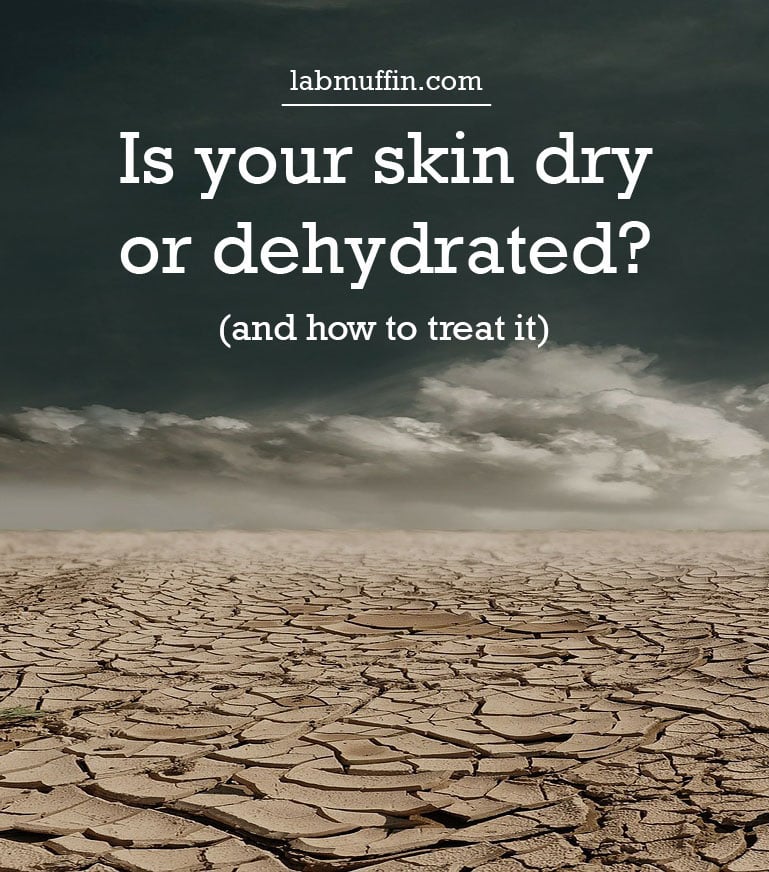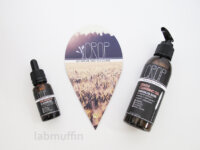
Note: I made a related video, with some updates! Here it is – scroll down for the written version.
For more on working out your skin type and conditions, building a routine, choosing products that fit your skin and lots more, check out The Lab Muffin Guide to Basic Skincare.
What’s the difference between dry and dehydrated skin?
Now that winter is coming to Australia, be prepared for flaky skin that makes you feel prickly at night and itchy all day. But what sort of flaky skin do you have? Dry and dehydrated skin are similar conditions, but with different causes, and hence different treatments. Both:
- are worse in cold and dry weather
- can cause flaky skin
- can be treated with moisturisers and other skincare products
The big difference is:
Dry skin lacks oil
Dry skin is a skin type that appears in almost all skin typing systems, and it means that your skin doesn’t produce enough oil. It’s the opposite of oily skin.
How much oil your skin produces mostly depends on your genes, but can also be mildly affected by your diet and the weather. This means that, if you have dry skin, you’re likely to have dry skin for a long time, unless you make drastic, permanent changes to your diet. The same applies to oily skin. Skin does get drier as you age though! The best level of oiliness is somewhere in the middle, which is often called “normal skin”.
Dehydrated skin lacks water
Dehydrated skin is a temporary condition that can happen to anyone: dry and oily skin can both lose too much water and become dehydrated! Usually, dehydration is a result of a weakened skin barrier – that is, the top layers of your skin are having a hard time slowing down the evaporation of water (technically known as transepidermal water loss or TEWL). This can be caused by cold dry weather, overwashing, overexfoliating, and sun exposure.
Is my skin dry or dehydrated?
Firstly, you need to work out your skin type – is it oily or dry?
Signs of oily skin:
- large pores and blackheads, especially in the T-zone (forehead, nose and chin area)
- visible oil on skin (shiny) or greasy spots on pillowcase
- moisturisers often make the oil worse
- prone to acne and breakouts
- make-up slides off during the day
Signs of dry skin:
- prone to cracking, rough patches and visible flakes
- moisturiser sinks in easily
- no visible shiny oil on skin
- small pores
- make-up settles into fine lines or around skin flakes
If you’re not sure from the descriptions, you can also try testing for oil using skin blotting paper or a layer of tissue or serviette. A few hours after washing, press the tissue or paper on your nose. If it sticks to your skin or shows a large grease spot, your skin is likely to be oily. If it doesn’t stick and there’s no grease spot, your skin is likely to be dry.
Now – is your skin dehydrated? In general, dehydrated skin feels tight and inflexible, instead of soft and plump.
If your skin is oily but still feels tight and paradoxically dry, like there’s a pool of grease sitting on brittle plastic, then there’s a good chance your skin is dehydrated.
If your skin is dry, you’ll actually be more prone to skin dehydration than someone who produces a lot of oil, as the oil helps keep the skin moist.
How to treat dry or dehydrated skin
Now that you know whether your skin lacks oil (dry) or water (dehydrated) or both (dry AND dehydrated, lucky you!), here’s how to fix it! The answer is… to put oil and/or water back into your skin. (Pretty obvious, right?)
To fix dry skin, use products containing oil in your skincare routine. There are 2 types of oil ingredients in skincare:
- Emollients sink into skin, making it supple
- Occlusives seal in water
Related Post: How to read an ingredients list: Face moisturisers
Both of these are suitable for dry skin. Products with a heavier texture will generally be suitable for dry skin. As well as moisturisers containing oil, you’ll also want to look into face and body cleansers that contain oil to replace any oil you wash away. These are often marketed as cream cleansers and cleansing milks.
To fix dehydrated skin:
- Use products containing humectant moisturiser ingredients. These are good at holding onto water, slowing down evaporation from your skin. Ingredients to look out for include glycerin, sorbitol, hyaluronic acid and urea.
- Apply your moisturiser while your skin is still damp from washing to seal in the moisture.
- Consider using an overnight mask – even something as simple as a thin layer of Vaseline over your usual night time skin products will help hydrate your skin overnight.

Related Post: Hydrating Toners Review
Product Suggestions
Dry Skin Moisturisers
Dry Skin Oils
Dry Skin Cleansers
Cleansing Oils
Micellar Waters
Dehydrated Skin Moisturisers
Dehydrated Skin Toners
Thermal Waters
Dehydrated Skin Cleansers
Dehydrated Skin Sleeping Masks
Things to avoid for both dry and dehydrated skin
- Exposure to the elements (sun, heat and wind)
- Long hot showers and strong cleansers and soaps which quickly strip away your skin’s natural oils and humectant moisturisers (the natural moisturising factor or NMF)
- Air conditioning which dries out skin
- Alcohol-containing toners which speed up water evaporation and wipe away oils
- Harsh physical exfoliants that leave your skin stripped and more permeable
- Overuse of drying active ingredients such as retinoids and benzoyl peroxide






After following you on IG, I’ve finally decided to follow your blog. Love these very useful tips. While reading on, I’m glad that I’ve made the right choices with regard to the products I should be using and I’ve taken really good care of my skin. Mine is usually normal to dry but when it’s steering on the dry side, I learned to adjust with the products I use.
xoxo,
Gelleesh.com
So many things to be learnt! I always thought I had dry skin due to flakes on my nose and cheeks although my skin gets oily throughout the day. Now I know that I actually have dehydrated skin instead of dry skin! Thank you!?
Great article!
One question: what is considered ‘excessive use’ of retinol? I’ve heard that it makes sense to use it in cycles before, but there is never a specification as to how long a cycle should last, and what kind of pause in between cycles there should be. Thank you!
This was so great definitely helped me out a lot! Xo
http://www.laneyslooks.com
This is a great method to know skin type. I’m impressed. The treatment to fix dry and dehydrated skin are easy and great idea. These are really very helpful for many people who are facing skin problems.
Good job, Keep doing your work like this and help others.
Hm, I’ve been spraying my face with orange blossom water (as an alternative to those fancy thermal waters)… I think I may need to try putting a bit of glycerine in my orange blossom water. 😉
Thanks for the tip!
Awesome articles & differences between skin type are great mentioned. This is an excellent post for everyone(readers, needy persons and etc.). This is such a brilliant post. Keep doing your job and wishing a great day 🙂
This is an informative blog for skin dry or dehydrated skin. Nice treatment I faced this problem last month, but I have used dehydrated skin care products. Now got more information from your blog. I should be sharing this blog to another through social media.
Thanks Natasha! Luckily it’s getting more humid in Sydney now so my skin is happy… but my hair is not! 🙁
Don’t you need an occlusive for a humectant to work? I’ve read that humectants lose the water they hold unto if there isn’t a barrier and that they will draw water from the air in this case OR if the climate is dry from the deeper layers of your skin. So no occlusive+dry climate would equal drier skin.
I’ve heard mixed things about the humectant/skin thing – it’s safest to have an occlusive on top, though not necessarily in the same formulation.
Thanks for letting me know that not seeing signs of shiny oil on my skin means that it is too dry. I started to notice that it also looks flaky and patchy as you described even if I just got out of the shower. I hope that I can find an organic lotion that could fix these skin issues with a lavender scent.
I read that moisturizers can make your skin lazy.
‘In a study in the British Journal of Dermatology, volunteers moisturized one forearm and left the other untreated for 7 weeks. At the end of the study, the treated arm was drier than the arm that got no moisturizer at all. A similar study in the journal Acta Dermato-Venereologica took the results one step further: The treated arms not only showed more water loss but were much more easily irritated. While both studies involved the body, results might be even more dramatic on facial skin, which isn’t protected by clothing.
At the end of one 7-week study, skin that was regularly treated with moisturizer felt drier than skin that got none at all.’
https://www.prevention.com/beauty/a20501063/your-expensive-moisturizer-could-be-seriously-dehydrating-your-skin/
What do you think?
I’m not sure if I landed on the same studies as they’re referring to (I didn’t see any links in the article) but the most commonly cited BJD and ADV studies on moisturisers actually tested multiple moisturisers, and some increased hydration/reduced irritation while others didn’t – which points towards the fact that SOME moisturisers can dry out skin in the long run, while others don’t, rather than anything about moisturisers making your skin “lazy”…
These are the ones I found – if it’s these studies, they didn’t summarise them very accurately:
https://onlinelibrary.wiley.com/doi/abs/10.1111/j.1365-2133.2006.07685.x
https://www.semanticscholar.org/paper/Effect-of-moisturizers-on-skin-susceptibility-to-Held-Agner/e2beb78e54145d5de87116f0be7fe0f769f9accc